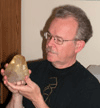| View previous topic :: View next topic |
| Author |
Message |
bugrock

Joined: 24 Nov 2008
Posts: 137
Location: Michigan


|
 Posted: Dec 12, 2009 18:18 Post subject: Another Notation Question Posted: Dec 12, 2009 18:18 Post subject: Another Notation Question |
|
|
Another question regarding notation. What is the meaning of the suffixes in the following mineral names?
Ferronigerite-6N6S
Ferronigerite-2N1S
Zinconigerite-2N1S
Magnesiotaaffeite-6N’3S
Magnesiotaaffeite-2N’2S
Thanks again |
|
| Back to top |
|
 |
GneissWare

Joined: 07 Mar 2008
Posts: 1287
Location: California



|
 Posted: Dec 12, 2009 19:17 Post subject: Re: Another Notation Question Posted: Dec 12, 2009 19:17 Post subject: Re: Another Notation Question |
|
|
Its complicated, and I'm not sure I can explain it -- but here goes:
These refer to polysomatic minerals with compositions that are linear combinations of the end members of the mineral group. In most senses, this is again a structural form of notation.
So, Ferronigerite-6N6S would have 6 N groups and 6 S groups.
clear as mud, huh!?! |
|
| Back to top |
|
 |
Pete Modreski
Site Admin

Joined: 30 Jul 2007
Posts: 709
Location: Denver, Colorado



|
 Posted: Dec 12, 2009 20:09 Post subject: Re: Another Notation Question Posted: Dec 12, 2009 20:09 Post subject: Re: Another Notation Question |
|
|
It's an interesting (and complicated) matter that this touches on. There are a number of subtle kinds of differences and gradational differences between crystal structures of closely related minerals, and a whole gaggle of mineralogists and crystallographers could probably spend a century locked up to debate whether all these different forms do or don't merit being considered separate minerals, and still not come up with a definitive answer.
These include differences such as those between argentite and acanthite, alpha and beta quartz (do we consider those two, to be one or two minerals?--I'm still not really sure), polytypes (found in mica and clay minerals, moissanite, molybdenite, pyrrhotite, and many more), regularly interstratified clays that are ordered alternations of different clay minerals, and these polysomatic minerals just referred to, about which I will admit I know rather little. How many of all these are "different" minerals--a good question!
It just makes one grateful that most of the commonly seen, well crystallized minerals, don't have these annoying complications.
Pete |
|
| Back to top |
|
 |
Pete Richards
Site Admin

Joined: 29 Dec 2008
Posts: 830
Location: Northeast Ohio



|
 Posted: Dec 12, 2009 21:44 Post subject: Re: Another Notation Question Posted: Dec 12, 2009 21:44 Post subject: Re: Another Notation Question |
|
|
My understanding may also be incomplete, but as far as I am aware, there are two different situations in which these suffixes are used. One is to distinguish between different structural forms of the same chemical formula, based on the sequence of stacking of atomic layers along a crystallographic direction, and the other is to distinguish between different chemical mixes in the same mineral. Your question seems to refer to the latter, but collectors will encounter both and may be confused by the similar notation..
The best example in my experience of the former convention is sphalerite and wurtzite, which differ in the sequence of layers along the body diagonal direction of the cubic sphalerite structure. Given a layer of close-packed (think pennies shoved as close as they can go to each other) of sulfur atoms, there are two possible positions in which to place the next layer of sulfur atoms, to maintain the observed closest packed structure. Call the first layer A, and the two next possibilities B and C, each of which lie over (a different set of) triangular holes in layer A. You can confirm this with pennies, it's cheap... If you build a structure following ABCABCABC... you get sphalerite and it's isometric. If you build any(?) other non-random sequence, it's hexagonal and it's wurtzite. The number of layers until you get a repeat, and the symmetry of the result, is indicated in a suffix. So we have sphalerite, which could be notated (for consistency, but is usually not) sphalerite-3C (3 for ABC... and C for cubic), and we have wurtzite-2H (ABABABAB...), wurtzite-4H, wurtzite-6H, wurtzite-15R (H: hexagonal symmetry, R: rhombohedral symmetry), and as I recall wurtzite-21R. If you want to know the stacking sequence for these more complex structures, you'll have to go to the literature!!!
Synthetic silicon carbide has even greater stacking polytype complexity. The same notation is used with micas and maybe with clay minerals.
The other suffix notation has to do with what element is dominant in a mineral that has a chemical substitution series between two (or more) pure end members. The use is, I think, not entirely consistent, and in flux, but basically it indicates which of several possible elements dominate in a given position in the structure. Thus ancylite-(Ce) indicates that this is ancylite with Ce dominant over the other candidates (presumably other rare earth elements). Recently this nomenclature is being applied to other minerals, and it's getting even more complex. But for example, apatite with fluorine dominant (the typical situation) would be apatite-F, and hydroxyapatite would be apatite-OH.
You seem to present a third situation (aarrghhhh!) in which there are various rational ratios of a chemical mix. Consider (Ca,Mn)CO3 - a solid solution series between calcite and rhodochrosite. If this is a continuum, we just write it that way and report the percent of calcium and manganese. But if it turns out that the ratios of Ca and Mn are always 1:0, 2:1, 1:2, and 0:1, then we can describe this as Camancarb-Ca, Camancarb-Ca2Mn1, Camancarb-Ca1Mn2, and Camancarb-MN. In this case, we've divided a solution series into four species (with basically the same name), which may reveal details but certainly adds complexity. And we've lost the familiar calcite and rhodochrosite.
The problem with all of this stuff is that if you have not spent 10,000 of your currency on analyses, you may not know what species you have. And if you have spent that money, you only know for sure the identity of the spot or the fragment or the crystal that you've had analyzed, from the specimen you want to label. The result may or may not apply to the rest!
The appropriate response for us collectors is to lighten up on the "must have this identified to species" notion. If you know it's a mica, label it as such, and don't worry if it's annite or polylithionite. If you know it's donnayite but don't know if it's donnayite-(Y) or donnayite-(Nd), label it donnayite. If you know it's a carbonate (fizzes in HCl), but don't know more, label it as such. If you know it's sphalerite with 74% atomic percent zinc and 26% atomic percent iron, label it as such and attach documentation.
All available information (including what is not known) is valuable; guesses are not!
(Sorry, but you asked....)
_________________
Collecting and studying crystals with interesting habits, twinning, and epitaxy |
|
| Back to top |
|
 |
Antonio Alcaide
Site Admin

Joined: 23 Aug 2009
Posts: 314
Location: Spain



|
 Posted: Dec 13, 2009 04:49 Post subject: Re: Another Notation Question Posted: Dec 13, 2009 04:49 Post subject: Re: Another Notation Question |
|
|
Thanks to Pete and the rest for your explanations.
Especially Pete Richards' explanation is clear and practical. I agree with you: it's no worth insisting on labeling with an impossible level of detail. Although I studied Arts, I was introduced in Science too and I was told about the problem of qualitative and quantitative measure. The classic notation was qualitative and now IMA is introducing a system of mixed notation -with quantitative attachments-.
For collectors I think the simpler the better. It's impossible to have your entire collection analyzed.
Regards,
Antonio
_________________
Life is the shortest crystal |
|
| Back to top |
|
 |
bugrock

Joined: 24 Nov 2008
Posts: 137
Location: Michigan


|
 Posted: Dec 13, 2009 15:53 Post subject: Re: Another Notation Question Posted: Dec 13, 2009 15:53 Post subject: Re: Another Notation Question |
|
|
| bugrock wrote: |
Thanks all for the explanations and comments.
Previously thought I was good at geometry until I developed an interest in minerals and
tried to understand ion packing etc. Certainly difficult to wrap your mind around some
of the concepts such as stacking sheets of spheres etc.
No hang up here regarding the exact identity of a piece. After all one of my
favorite groups are the Fe/Mn oxides/hydroxides. Simple formulas but many specimens
in this group can be a soup of stuff based on simple tests like looking at the streak, all depends
on which corner of the specimen you choose to test just as was mentioned in the case of formal analysis.
Trouble is with the internet anyone can now access so much information for which
one may not have the background to completely understand. Still for me some of the
chemistry/material properties adds interest to the whole pursuit. An example is the mineral
Perovskite. Materials with the "perovskite" type structure have a number of uses. Just check
the Wikipedia site below. Complex stuff but makes me wonder if some of the properties
noted were first discovered by investigating natural occurring samples of minerals with this
structure.
https://en.wikipedia.org/wiki/Perovskite_%28structure%29
I too love to collect minerals but also like to dig a bit deeper.
Science can be fun.
|
Sorry but I found one more example!
Is there somewhere a glossary to indicate how the capital letters are used in these formulas?
(N and S in one of my prior messages and R and E in this example.) Here the capital letters
are used in the middle of the formula rather than as a suffix:
Kamphaugite-(Y): Ca(Y,REE)[OH|(CO3)2] · H2O
All elements listed in formula: C, Ca, H, O, Y
What is the meaning of “REE” in this formula?
(formula and elemental information copied from mindat)
Thanks |
|
| Back to top |
|
 |
GneissWare

Joined: 07 Mar 2008
Posts: 1287
Location: California



|
 Posted: Dec 13, 2009 16:14 Post subject: Re: Another Notation Question Posted: Dec 13, 2009 16:14 Post subject: Re: Another Notation Question |
|
|
| REE is shorthand for the Rare Earth Elements (La, Ce, Pr, Nd, Pm, Sm, Eu, Gd, Tb, Dy, Ho, Er, Tm, Yb, Lu), which have the same outer electron configuration, and therefore have similar chemical behavior (easily substitute for each other in the mineral structure). |
|
| Back to top |
|
 |
Pete Richards
Site Admin

Joined: 29 Dec 2008
Posts: 830
Location: Northeast Ohio



|
 Posted: Dec 13, 2009 16:29 Post subject: Re: Another Notation Question Posted: Dec 13, 2009 16:29 Post subject: Re: Another Notation Question |
|
|
REE refers to a group of elements together, the Rare Earth Elements. They tend to occur together, though some are more common than others. Wikipedia has a good article on them.
_________________
Collecting and studying crystals with interesting habits, twinning, and epitaxy |
|
| Back to top |
|
 |
|


